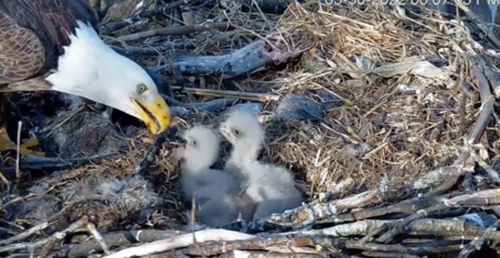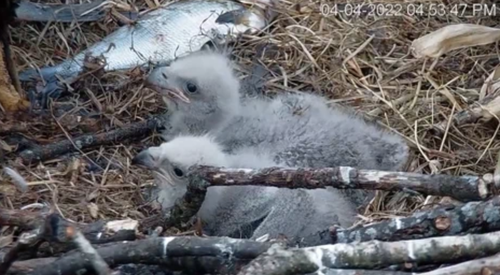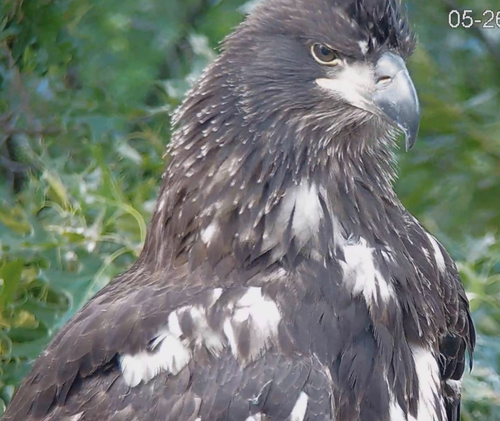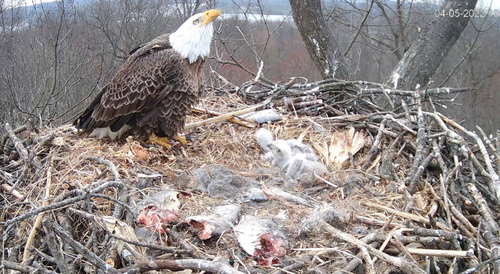Hanover Bald Eagle Blog # 13 - 2022
In partnership with Pennsylvania Game Commission and Comcast Business .

Every year, bald eagle nest cams receive viewer questions about sibling aggression. Questions like, which factors influence whether siblings get along or not? How likely is aggression to occur? Is the youngest chick in danger? These are good questions, with no short answers. Nest dynamics are influenced by environmental factors, like how much food is available, as well as set factors, like how many days apart the eggs hatched.
The further apart in age two nestlings are, the larger their size difference, and the more likely they are to fight. The first-hatched nestling has an advantage. We all know that big brothers and sisters have a tendency to push their younger siblings around, but in an eagle nest, there is more to it than that.

As mentioned in Blog 12, bald eagles hatch asynchronously, meaning the eggs hatch anywhere from 1 to 4 days apart. In years where there are plenty of resources to go around, issues rarely arise. However, during periods of food scarcity, sibling aggression often surfaces, leading to physical harassment, food hoarding, or eviction initiated by the eldest chick. With enough persistence, these activities can result in the death of the youngest. This may sound brutal, but in raptor life, it’s common. While the concept of siblicide, as the act is called, seems morbid to us, throughout the rest of the animal kingdom there are many examples for which the circle of life is rough around the edges. The death of one chick may result in the survival of their sibling since all of the food brought back to the nest will feed one mouth instead of two.
Seen through this lens, by laying eggs asynchronously and giving one chick an advantage from the get-go, eagle parents increase their chances of raising at least one healthy, reproductively capable youngster. For bird species whose chicks hatch at the same time, called synchronous hatching, all of the young are equally capable of fighting for food. This means that in times of food shortage, all chicks suffer, potentially resulting in zero young surviving overall.
Asynchronous hatching is likely a built-in reproductive strategy that results in a higher number of healthy young leaving the nest, therefore providing an overall benefit to the population.

Ornithologists frame this parenting approach in a way that can help us understand why asynchronous hatching is a beneficial strategy for bald eagles as a species: Reproductive success is not defined by the number of eggs that are laid, or the number of fledglings that leave the nest. Rather, success is measured by how many offspring are able to produce their own young. It is in the parents best interest to ensure that at least one chick leaves the nest healthy enough to, five years down the road, raise a family of their own.
On the bright side, while Bald Eagles have been known to engage in siblicide, researchers suspect that it occurs in fewer than 5% of all nests. On the even brighter side, sibling aggression between the Hanover chicks is unlikely to occur this season. Here’s why:
Ian Newton, the granddaddy of raptor ecology, identified several factors that influence the outcome of sibling aggression (specifically, whether aggression results in death). They are:
- The hatching interval, which determines the difference in size between nestlings.
- The rate at which parents feed the nestlings, which influences how often the larger nestling attacks its nestmate.
- The amount of time the chicks are left alone in the nest, which is when attacks are most likely to occur.
Newton adds that this final factor is tied to food availability, because if both parents must hunt at the same time due to lack of sufficient food, the nestlings are left alone more often.
Let’s consider these three factors and see how the Hanover nest is shaping up this season:
- Hatching interval = 1 day
- Feeding rate = high
- Time left alone = low
The nestlings are relatively similar in size since they hatched only 24 hours apart. The sex of the nestlings does influence their growth rates and size, with female bald eagles being 25% larger than males, but sex is difficult to verify during the nestling phase. See last year’s Blog 16: Male or Female for a recap on size differences between male and female bald eagles, both in the nest and out.
The Hanover parents have been feeding the nestlings often, meaning the feeding rate is high. I mean, look at all of those prey items…

And lastly, the Hanover parents rarely leave the nestlings alone at this stage of development. The presence of the adults is important while the nestlings are young, not only to protect them from predators, but also to keep them warm and shielded from inclement weather. Gradually, the nestlings will be left alone for longer periods of time, but for the first 2-3 weeks, the female will be present at the nest 90% of the time, and the male 50% of the time. Someone will be there pretty much at all times. After 5 weeks, the parents will spend less time at the nest while still remaining attentive, watchful and aware of their offspring’s needs from a nearby perch.
Based on Newton’s ideas about which factors influence sibling aggression, the Hanover nestlings are on their way towards peaceful cohabitation, and hopefully, some semblance of sibling affection.
Sources
Buehler, D. A. (2020). Bald Eagle (Haliaeetus leucocephalus), version 1.0. In Birds of the World (A. F. Poole and F. B. Gill, Editors). Cornell Lab of Ornithology, Ithaca, NY, USA. https://doi.org/10.2173/bow.baleag.01
Cornell Lab of Ornithology. (2004). Handbook of Bird Biology. Princeton: NJ: Princeton University Press.
Estes, Wendy A., Dewey, Sarah R., and Kennedy, Patricia L. (1999). Siblicide at Northern Goshawk Nests: Does Food Play a Role? The Wilson Bulletin, Vol. 111(No.3), 432-436.
Hedgpeth, Dana. (2016, March 22). Two baby bald eagles show sibling rivalry at National Arboretum. https://www.washingtonpost.com/news/local/wp/2016/03/22/two-baby-bald-eagles-show-sibling-rivalry-at-national-arboretum/?noredirect=on&utm_term=.21c46011cc2a
Newton, Ian. (1979). Population Ecology of Raptors. T & A D Poyser Ltd.

RETURN TO HANOVER BALD EAGLE BLOGS
WATCH THE HANOVER BALD EAGLE LIVE CAMS
For over 20 years, HDOnTap has provided live streaming solutions to resorts, amusement parks, wildlife refuges and more. In addition to maintaining a network of over 400 live webcams, HDOnTap specializes in design and installation of remote, off-grid and otherwise challenging live streaming solutions. Contact press@hdontap.com for all media needs, including images and recordings.

